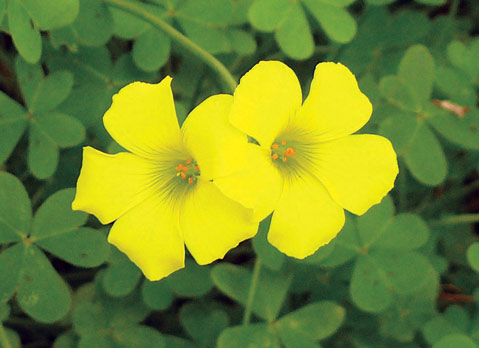Tough Weeds
Techniques to Rid Your Garden of Invading Plants

Weeds come in many different shapes and sizes, but the key to getting the upper hand when they invade is in understanding how they grow and reproduce (unfortunately, very often at a much faster rate than more-desirable plants). Some of the worst weed candidates lurk below the ground, waiting for the slightest opportunity to sprout and fulfill their dastardly destiny. They do this by quickly forming small bulbs or nutlets on their roots that can persist for long periods of time in dormancy.
A couple of the worst of these weeds are sour grass (Oxalis pes-caprae) and nutgrass or nutsedge (Cyperus rotundus).Well below the surface of the soil, both of these species form small bulbs that can stay dormant in the soil for years and spread easily when it is tilled. Just pulling the plant doesn’t guarantee that all the roots with their bulbs will be removed. It’s quite likely that many will remain to sprout anew.
One technique that can make good inroads against bulbous weeds is smothering. This is a somewhat novel mulching technique, but with diligence, it will do the job. The trick is to thoroughly exclude light and physically impede the new growth for long enough that the shoots aren’t able to reach into the sunlight. This eventually depletes the bulbs’ stored resources, and the weed will die. Plastic films will accomplish this for sour grass, but amazingly, nutgrass shoots are so sharp they can penetrate the plastic. Plastic mulches also do nothing to contribute to the natural soil biology. In fact, the trapped heat may seriously reduce numbers of beneficial bacteria, fungi, and earthworms.
Biodegradable mulch materials with the requisite attributes are as close as the recycling bin. In numerous home gardens and research plots, newspaper and cardboard mulches have been shown to last long enough to smother both of these enduring weeds. Here’s how to go about it. Start by thoroughly watering the area. Then spread five or six layers of regular newsprint (not the colored or glossy sections) or one layer of corrugated cardboard (not plastic coated) between the plants of the infected area. Be sure to overlap the materials by several inches to securely block out light and impede the rogue shoots.
This won’t be pretty, of course, so cover the paper products with a generous layer (two or more inches) of shredded leaves, straw, or some other tidy-looking organic material. Give the area another sprinkling just to settle everything, and walk away. Monitor the soil moisture under this mulch carefully. If it remains too wet, surrounding plants may drown; too dry and the mulch layer may dry out and create a water-repellent layer. Within one or two seasons, the paper mulch layer will rot away. At that point, continue to add the regular mulch materials to keep the soil covered. Any weed seeds that arrive on top of this mulch are easily dislodged, and even the few nutgrass or sour grass sprouts that have made it through against all odds can be pulled, too. Young shoots, if pulled early in their life, will not be able to feed the underground bulbs, and eventually the underground nutrient supply will be completely depleted. To continue planting in a “smothered” area, clear just the area needed to plug in new plants, and tuck them in. Just remember to keep the tilling (and possible spread of bulbs) to a minimum.



